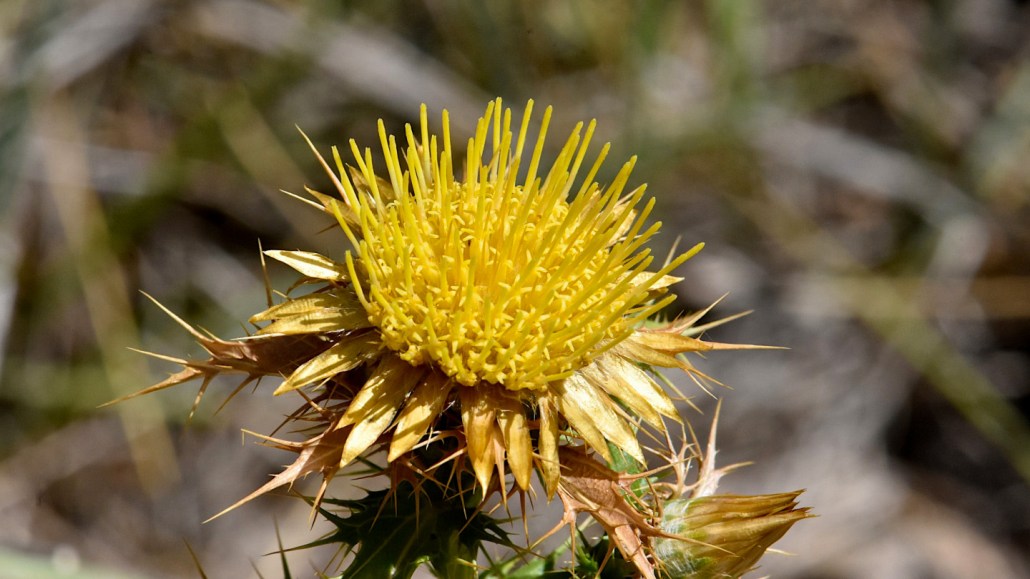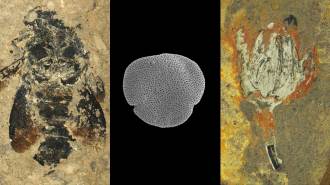
In southern Spain, summer heat can make life tough for a plant. The thistle Carlina corymbosa beats the heat by somehow cooling down its flowers to well below air temperature.
Carlos Herrera
In the mountains of southern Spain, one type of thistle plant seems to have built-in air conditioning.
The flowers of the thistle Carlina corymbosa are, on average, about 3 degrees Celsius cooler than the surrounding air, ecologist Carlos Herrera reports February 13 in Ecology. The most extreme cooling — sometimes up to 10 degrees C — occurs during the hottest part of the day. This means when the air temperature reaches a sweltering 45° C, the plant’s flowers can remain close to a relatively cool 35° C.
“Those are substantial coolings relative to the air next to it,” says Christopher Still, an ecologist at Oregon State University in Corvallis who was not involved in the work. “It’s a nice, careful study.”
In Spain’s Sierra de Cazorla mountain range, scorching summers leave many plants dead, dried out or dormant. This brown sea is intermittently broken by bursts of yellow, as C. corymbosa improbably peeks its flowers above the vegetation. When Herrera, of the Spanish National Research Council in Sevilla, touched one of the flower heads during the peak of the day’s heat on a recent trek, he found it pleasantly cool.
Herrera was there to study the relationship between the region’s plants and their pollinators. He bent to touch the thistle because he “was checking for the presence of nectar in the flower head,” he says, and then became curious about why the flower felt chilled.
Using an electric thermometer, he measured the temperatures of seven different thistles across two sites and multiple days per flower. He found the flowers consistently cooled down as the day grew hotter.
Many plants cool down by passively allowing water to evaporate through pores, a process called transpiration that is analogous to humans beating the heat by sweating (SN: 2/27/06). Most research has focused on how leaves keep cool, but in many cases, leaves don’t get colder than the surrounding air. When they do, Herrera reports, the difference in temperature is less drastic than seen in the thistle flowers.
There’s probably some truth to the idea that the thistle cools itself down more than leaves, but because flowers and leaves are measured differently, it’s hard to say for sure, Still says.
Because the thistles started cooling down at the hottest part of the day, it’s possible that the plants are actively turning a self-refrigerating mechanism on and off.
The idea that plants might be controlling their internal temperatures took off in the late 1980s, and is known as “limited homeothermy.” However, this is a rare skill among plants, Still says. A 2022 study he led found no evidence that leaves in forest canopies across North and Central America were cooler than the air around them.
Both Herrera and Still think that something about the thistle flower’s shape and structure enables it to cool off so effectively.
Herrera suspects that as water within the thistle evaporates, it takes heat with it, and because of the flower’s physical form, that heat isn’t being replaced by the sun’s warmth. This might allow the plant to cool below the air temperature. Herrera dubs this the “botijo effect,” because “it is the same principle by which porous sweating pitchers” — called botijos in Spanish — “cool themselves in dry, hot air.” This idea needs to be tested, however.
Herrera and Still are both curious to know if being cooler than the surrounding air provides any benefit to the thistle, such as by attracting pollinators trying to escape the oppressive summer heat. Herrera plans to see if other thistles in southern Spain show the same cooling effect and has also mapped out an experiment to probe how limiting the plant’s access to water may influence its cooling ability.
“There’s a lot of value in old-fashioned naturalism,” Still says. “This one study could lead to lots of cool follow-on work.”







